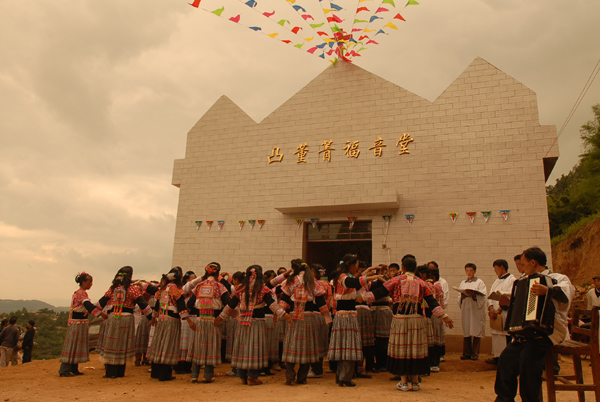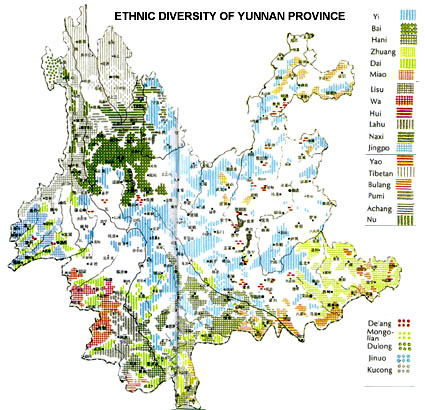Peeks into a home and into a backyard.
Visit to a Miao Village -- Page 4
__
Peeks into a home and into a backyard.
 __
__
In front of the new church.
_
Signs of change!
__
And a goodbye meal; one chicken and a twelve course meal!
So who are the Miao people and how can it be that this Christian
Miao village
exists in this remote area of China?
First the Miao -- They are one of 56 native cultures or ethnic groups in China. Well over ninty percent of people in China are Han Chinese. The rest of the population is made up of 55 different ethnic groups. The Southwest Province of Yunnan is remote and mountainous and borders Burma (Mynamar), Laos, Vietnam and four provinces of China including Tibet. Because of these factors there are 26 ethnic groups that inhabit Yunnan, which makes it the most culturally diverse province of China. To see some of Jin Fei Bao's photographs of other minority people in Yunnan CLICK HERE.
The following map illustrates the compexity of the distribution of ethnic groups in Yunnan:

From Wikipedia: The Miao are a linguistically and culturally related group of people recognized by the government of the People's Republic of China as one of the 55 official minority groups. Miao is a Chinese term and does not reflect the self-designations of the component sub-groups, which include (with some variant spellings) Hmong/Mong, Hmu, A Hmao, and Kho (Qho) Xiong. The Miao live primarily in southern China, in the provinces of Guizhou, Hunan, Yunnan, Sichuan, Guangxi, Hainan, Guangdong, and Hubei. Some members of the Miao sub-groups, most notably Hmong/Mong people, have migrated out of China into Southeast Asia (northern Vietnam, Laos, Myanmar (Burma) and Thailand). Following the communist takeover of Laos in 1975, a large group of Hmong/Mong refugees resettled in several Western nations (United States, France, Australia, and elsewhere.) For the full article CLICK HERE.
Considerable support and research pertaining to the Miao (Hmong) is being done in St. Paul, Minnesota where many Hmong/Miao people have resettled.
See Hmong Cultural Center, the Hmong Studies Internet Resource Center and HmongNet.org
Second, the Christian Miao Village -- Christian missionaries around the world and in China have a long and complex history. Last year, when I was collecting magic lantern slides for an exhibiton in China, I discovered that many of the earliest photographs of China were taken by Christian missionaries. These were primarily used to educate audiences and seek funds back in the Western world. In searching for the history of this Christian Miao village, I have only traced a few strands of this complex web, which I present below. If anyone reading this has more detailed information, I will appreciate hearing from you (gmillett@nycap.rr.com).
During my 2006 visit, I was told by one of the Miao community leaders (through an interpreter) that "Christian missionaries came to us a long time ago. They lived and died with us. And we have been a dedicated Christian community ever since. We do not drink alcohol, smoke or lock our doors and on special Christian holidays the villages in our area get together to celebrate."
The Jin Fei Bao documentary offers the following information: Pastor Bogeri, from the Shikamen area, taught the people in Gong Dong Qing the gospel and how to read in the Miao language. The first Christian shrine was in Huaming Village and by 1903 Christianity had reached Sanpu Hill of Wuding County. In 1904 it reached Gong Dong Qing; it took 32 years. Pastor Long and other missionaries also taught us.
Fei Bao also writes that "in 1923, Guo Xiu Feng established Northwestern Yunnan Six Minorities League, and established the Miao Missionary General Committee in Sa Pu Mountain, and Mu Yang Church is one of the seven branches. Mu Yang Church took charge of churches in Fu Ming, Song Ming and West Hill District. From 1925 to 1945, Long Xue was the elder and Zhang Xing Yi was the preacher."
From internet searches it appears that the China Inland Mission, now the OMF (Overseas Missionary Fellowship International), founded by James Hudson Taylor in England in 1865, was the principal Christian outreach to southwest China. It is remarkable that "Taylor spent 51 years in China. The society that he began was responsible for bringing over 800 missionaries to the country, began 125 schools and directly resulted in 18,000 Christian conversions, as well as the establishment of more than 300 stations of work with more than 500 local helpers in all eighteen provinces. He was known for his sensitivity to Chinese culture and zeal for evangelism. He adopted wearing native Chinese clothing even though this was rare among missionaries of that time. Under his leadership, the CIM was singularly non-denominational in practice and accepted members from all Protestant groups, including individuals from the working class and single women as well as multinational recruits. Primarily because of the CIM's campaign against the Opium trade, Taylor has been referred to as one of the most significant Europeans to visit China in the 19th Century. Taylor was able to preach in several varieties of Chinese, including Mandarin, Chaozhou, and the Wu dialects of Shanghai and Ningbo. The last of these he knew well enough to help prepare a colloquial edition of the New Testament."
The Wu and Ningbo are two of the minority cultures in Yunnan and it appears that Taylor's most influential missionary in southwest China was Samuel Pollard. "in 1891 Polard was posted to a newly opened Bible Christian mission station in Chaotung. He began a Christian movement with the Big Flowery Miao in 1905 that spread to Chaotung. Pollard also invented a script for the Miao language. During his mission he travelled extensively, founding churches, training other missionaries, performing the role of language examiner, and arguing the causes of Miao Christians."
Samuel Pollard also wrote several books including The Story of the Miao, Tight Corners in China, In Unknown China: observations, adventures and experiences of a pioneer missionary and Eyes of the Earth. I have so far only located In Unknown China and it is a remarkable document. Let me give you a couple examples of his writings:
The student of ethnology finds himself in his element when he reaches the populous western provinces of China. If he attends one of the important village markets on a market day he will hear a number of different languages spoken, see representatives of several different tribes, and watch as animated and interesting a scene as his heart could wish for. The small-footed Chinese woman with the long baggy trousers is but one of the many women on the market, and her crippled, unnatural walking motion compares very unfavourably with the quick, upright, graceful movements of the hillwomen, who would scorn to bind their feet, and who walk like women of a conquering race. Miao men with double pigtails, Nosu women with long skirts almost sweeping the ground, hill lasses with short skirts of many colours and long plaits of hair almost golden at the tips, strapping Min-Chia women bearing huge bundles of firewood hung by a strap around the forehead, here and there a Babu man with his long felt cape made, pleats and all, in one piece, women with curious horns on their heads, others with huge combs stuck crosswise in the back of their hair, long skirts and short skirts, wide trousers and no trousers, shoes of many colours and shapes and, prettier and more graceful than all, the five-toed natural foot, revealing no trace of deformity and equal to a hearty exciting dance on the hill-sides—these the traveller sees in markets of many parts of West China.
ONE of the Nosu who went across the Yangtse with us was a relative of the people who lived at the See-tieh farmstead. Going outside the house on one occasion, I saw a number of the slave girls of the establishment " ragging " this young fellow in a more lively way than he seemed to relish. They were pushing and pulling him about quite roughly, and apparently very much enjoying the fun. The young fellow, being alone, was no match for this lively bevy of farm girls. Ragging is more common among Orientals than has been supposed. One can pick up some lively stories of the ragging of Chinese bridegrooms by the women of the household when he takes his bride home to her friends on the third day after the wedding. Here again we found that in Nosuland the scene we looked on, where the young man was getting quite the worst of the fun, was in accordance with Nosu customs. If a young man pays a visit to any of his relatives the women and slave girls of the household are allowed to get what fun they can out of the visitor. If he objects, this only adds more fuel to the fire of the fun. If he is good-natured and joins in as heartily as the rest he wins the respect of the girls, which is quite worth winning. One part of the fun is to get a gourd of water and try to throw it all over the visitor. He, of course, knows what to expect, and is on his guard and pays them back as well as he can.
I'll end this "Visit to a Miao Village, with one of Fei Bao's favorite stories: Fifteen years ago, when he stumbled upon the village, he was exhausted from his treking and was taken in by the people and given good food and a night's rest. When he departed he invited the village head to pay him a visit someday in Kunming. Well, three months later, there was a knock on his office door and there in the courtyard were thirty Miao people from the village! He scrambled around finding blankets and space in his office so that everyone could have a bit of floor space to spend the night. However, it turned out that no one slept; they spent the entire night watching television! The next day he chartered a bus and gave his visitors a day's tour of Kunming. Since then he has gone to the village at least twice a year, especially at Christmas, and has helped bring public sanitation and satellite television to Gong Dong Qing and, as I mentioned earlier, secured the funds for the new village church.
To watch Jin Fei Bao's 22-minute documentary of the Gong Dong Qing Miao Viallage CLICK HERE.
Additional Information:
General history of Christianity in China
"Searching the Foot Prints of God in Southwestern China" by Robert Lin (journey to Shimenkan -- center of Hmong/Christian culture)
New information received since I posted this page on February 20, 2010
"As a Chinese-American actor/writer/filmmaker, I'm based in both NYC and Beijing. I've been preparing a feature film about the life of a Miao Christian pastor for many years, which has been the very reason that I had visited Miao Christian churches more than once. My Chinese producing partner and I also are interested in making a film based on life story of Samuel Pollard. The two, eventually, could form a Chinese Miao Christian series." Robert Lin
"You might be interested to know that there is an organization to help minority children in Yunnan get education (significantly, in the present context, is a particular Miao village we've put a school in). Take a look at the Yunnan America Foundation" John Thorne
"I just saw your excellent pictures on Gong Dong Qing.
I visited Samuel Pollard's location in Zhaotong
in 2004, and recorded some of that in a post HERE.
One thing I can add to your history is that “Bó
GéLi” was the Chinese name for Pollard, so "Pastor Bogeli"
refers to Pollard." Brian T. Carroll